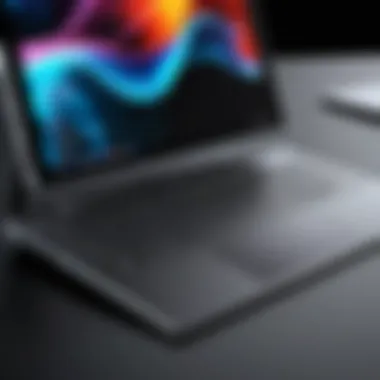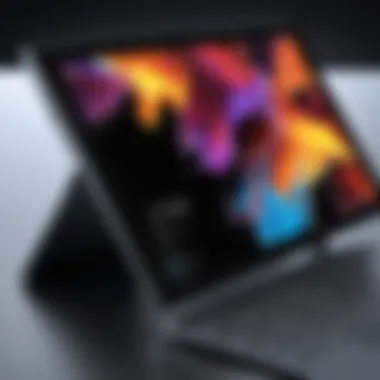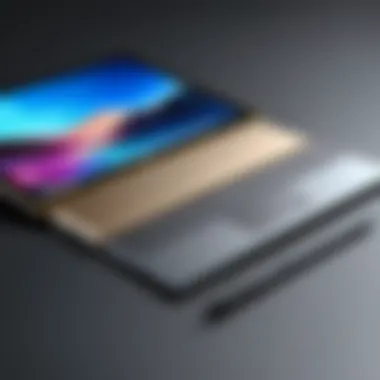Explore the Lightest Surface Pro: In-Depth Analysis


Intro
The landscape of personal computing continues to evolve, with devices increasingly prioritizing portability without sacrificing performance. Among these, the Surface Pro lineup from Microsoft stands out, offering a hybrid experience that caters to both the tablet and laptop markets. This article specifically explores the lightest Surface Pro model available, delving into its various features, specifications, and performance metrics. The intent is not merely to highlight its physical attributes but to contextualize it against its peers in the Surface family and, by extension, the broader category of hybrid devices.
Understanding technology choices is crucial for tech enthusiasts, gamers, and IT professionals. The rapid advancements in computing necessitate an informed decision-making process when selecting suitable devices. Consequently, this examination serves as a practical review, assisting readers in evaluating whether this particular model fits their requirements effectively.
Foreword to Surface Pro Models
The Surface Pro line has become a significant player in the hybrid laptop market. These devices blend the functionality of laptops with the portability of tablets, creating a unique offering in the tech industry. Understanding the Surface Pro models is essential, particularly when exploring the lightest option available. The difference in features, specifications, and design philosophy can greatly influence a user's decision on which model to choose.
Overview of the Surface Pro Lineage
The Surface Pro series began with its original model, introduced by Microsoft. This initial device set a standard for what a 2-in-1 device could be. Over the years, the line has evolved, introducing various iterations that improve on design, performance, and user experience. Each new model builds on the strengths of its predecessor while addressing user feedback and technological advancements. This evolution highlights the company's commitment to continuous improvement and user satisfaction.
The key models in this lineage include:
- Surface Pro (1st Gen): Established the form factor and functionality.
- Surface Pro 2: Offered enhanced battery life and improved kickstand.
- Surface Pro 3: Introduced a larger display and a thinner profile.
- Surface Pro 4: Featured higher resolution and better processing power.
- Surface Pro (5th Gen): Combined performance and portability effectively.
- Surface Pro 6: Provided a more vibrant color palette and better internals.
- Surface Pro 7: Added USB-C support and further improved performance.
Each generation reflects changing user needs and technological capabilities. The ongoing refinement of the Surface Pro line demonstrates how well it adapts to various demands, setting a benchmark for competitors.
The Evolution of Design and Specs
The evolution of the Surface Pro models is not just about improved specs but also about thoughtful design changes. Microsoft has focused on balancing aesthetics with functionality. In the earlier models, the emphasis was primarily on establishing the form factor, while newer iterations have pushed the boundary on portability and weight.
Key considerations in design evolution include:
- Weight Reduction: The trend has been clear. Each new model has become lighter, appealing to users who need portability.
- Durability: Material choices have evolved from plastic to more premium materials. This shift increases durability while keeping the devices lightweight.
- Display Upgrade: The displays have not only become larger but also offer better resolution. High pixel density enhances visual experiences, which is crucial for tasks requiring detailed graphics.
- Keyboard and Kickstand: The redesign of the keyboard and the introduction of more adjustable kickstands have improved usability significantly.
This attention to design ensures that as the technology advances, the Surface Pro remains relevant and user-friendly. With each iteration, users can find improvements that align with their needs, whether for work, study, or leisure.
Defining the Lightest Surface Pro
Defining the lightest Surface Pro is crucial for people looking to balance performance with portability. The demand for devices that are easy to carry yet powerful underlines the needs of today's tech users. Many professionals need devices that can keep up with their busy lifestyles while providing the necessary features for productivity. In this context, identifying the lightest model serves not only as a point of comparison but also as a catalyst for informed decisions. Understanding its specifications helps potential buyers gauge the performance capabilities without compromising on weight and ease of movement.
Technical Specifications
Processor Attributes
The processor of the lightest Surface Pro is a key element impacting its overall performance. Designed for efficiency, the Intel Core i5 or i7 provides sufficient power for demanding tasks while maintaining battery life. This choice is popular among professionals due to its ability to handle various applications seamlessly. Additionally, the unique feature of dynamic frequency scaling allows users to experience optimal performance without overheating. This attribute is a significant advantage in terms of energy conservation efforts.
Memory and Storage Options
Memory and storage options play an essential role in determining the functionality of the device. With options ranging from 8GB to 32GB of RAM, users can choose a configuration that meets their processing needs. Storage options include SSDs of up to 1TB, offering ample space for applications and files. The speed of SSDs significantly enhances data access times compared to traditional HDDs. However, a drawback is the cost of upgrading storage, which might be high for some budgets.
Weight and Portability
Weight and portability directly influence the user experience with the Surface Pro. Weighing approximately 1.7 pounds, this model is extremely lightweight compared to many other hybrids on the market. Portability is a prized characteristic for on-the-go users, enabling them to easily transport their devices. While such lightweight designs often favor easy handling, they also limit the richness of materials, potentially affecting durability in certain scenarios.
Design Aesthetics and Build Quality
Material Choices
Material choices in the construction of this Surface Pro model significantly affect the user experience. Utilizing magnesium alloy in the chassis provides a balance of strength and weight. This material is known for its robustness and light weight, making it an excellent choice for portable devices. The choice of high-quality materials means users can expect a visually appealing device that stands out. However, this may come at a higher production cost, which can inflate retail prices.
Color Options


Color options expand the appeal of the Surface Pro beyond functionality. Available in colors like platinum, black, and burgundy, these options cater to personal preferences among users, allowing for customization. The aesthetic appeal contributes to user satisfaction and brand loyalty. While color choices are often secondary to performance, they represent an essential marketing strategy.
Durability Assessment
Durability assessment is vital in establishing the reliability of the lightest Surface Pro during typical use. Despite being lightweight, the device's build quality suggests a resilience to everyday wear and tear. Users can expect a product that can withstand typical accidental drops or impacts. Nonetheless, with such a lightweight design, certain users might find it less suitable for extreme conditions, reducing its overall versatility for rugged environments.
The combination of light weight and quality materials makes the Surface Pro an attractive option for users who prioritize both portability and durability in their devices.
Performance Analysis
Performance analysis is a critical aspect of evaluating any computing device, particularly when assessing the lightest Surface Pro model. This section aims to dissect the elements of processing power and battery life, which are paramount for performance and overall user satisfaction. Understanding these facets will help potential buyers make informed decisions based on practical use cases. The implications of performance are far-reaching, impacting everything from productivity to gaming capabilities.
Processing Power Evaluation
Benchmark Comparisons
Benchmark comparisons serve as a reliable metric for gauging the performance of computing devices. They provide quantifiable data that can be particularly useful when comparing different models in a lineup. For the Surface Pro, tests may include processing speeds, graphics rendering capabilities, and overall responsiveness under various loads.
The key characteristic of benchmark comparisons is that they allow for apples-to-apples evaluations, offering users a clear picture of how the latest model stacks up against its predecessors or competitors. This is a beneficial choice for discerning users who prioritize raw power in their devices. While benchmarks can sometimes be abstract, they serve as a solid foundation for understanding the device's potential limitations and strengths in practical applications.
A unique feature of this analysis is the focus on multi-core performance, which is vital for users engaged in demanding tasks. However, a limitation can arise when relying solely on synthetic benchmarks, as they may not always translate to real-world scenarios where varied tasks are executed simultaneously.
Real-World Performance Insights
Real-world performance insights provide a contextual basis for understanding how capable the device is in everyday applications. Unlike benchmark comparisons, this evaluation considers user experiences across various scenarios, such as running multiple apps, video editing, or gaming.
The key characteristic here lies in its ability to paint a more complete picture of how the Surface Pro performs under load. This aspect is a popular choice for those interested in not just numbers but relatable, day-to-day usability. The unique feature of this analysis is how it captures user interactions, showing how well a device handles multitasking.
However, one should note the potential disparity between benchmark results and real-world performance. For instance, while a Surface Pro may score high in synthetic tests, its performance could waver in scenarios involving extended usage or specific heavy applications.
Battery Life Assessment
Battery life assessment is a crucial element in determining the practicality of the lightest Surface Pro model. It affects not only everyday usage but also the portability aspect of the device. In the age of remote work and on-the-go lifestyles, understanding how long a device can last on a single charge holds significance for many.
Usage Scenarios
Usage scenarios help to contextualize battery performance in real-life applications. This encompasses everything from simple document editing to intensive graphic design work. The key characteristic of these scenarios is how they evaluate battery life across different activities, illustrating the versatility of the device.
This is a beneficial analysis for individuals who plan to use the Surface Pro for varied purposes. One unique feature of this overview is that it considers background activities, such as syncing or notifications, which can have a substantial impact on battery life.
However, it's worth noting that battery life can differ significantly based on user habits and settings, which could lead to discrepancies in expected performance versus actual outcomes.
Charging Efficiency
Charging efficiency plays a vital role in how quickly users can get their devices back in action after a power drain. This consideration encompasses not only the charging speed but also how the device manages power during charging processes.
The key characteristic of charging efficiency is the technology behind it, including fast charging and adaptive charging capabilities. For this article, focusing on these aspects provides an beneficial avenue for potential users who prioritize quick turnaround times. The unique feature here is the seamless integration of power management into the Surface Pro's overall performance framework.
Nevertheless, a couple of caveats exist. For example, while rapid charging could save time, it may also heat the device higher than usual, affecting long-term battery health. Also, the time taken to return to full charge could differ under varying conditions, introducing a variable aspect in this discussion.
User Experience and Interface
In the realm of technology, user experience and interface play a pivotal role in how users interact with devices. For the lightest Surface Pro model, these elements are essential. They determine how effectively the user can navigate, execute tasks, and enjoy the multimedia features. A satisfactory interface not only enhances productivity but also influences overall satisfaction with the device.
Operating System Features
Windows Integration


Windows Integration in the lightest Surface Pro is a significant merit that simplifies user interaction. The system is designed to work seamlessly with various Windows applications, allowing users to utilize familiar software tools without hurdles. This aspect is especially vital for professionals who rely on specific applications for their work.
One key characteristic of Windows Integration is its adaptability across different tasks. Users can easily switch between tablet and desktop modes, making it a versatile choice for various scenarios. This flexibility provides a unique advantage for multitasking.
However, there are some downsides. Certain apps may not fully utilize the capabilities of the Surface Pro, leading to some performance lags. Still, the overall consistency of performance remains high, supporting the device's reputation as efficient for business and personal needs.
Touch vs. Keyboard Experience
The debate between touch and keyboard experience centers on how users prefer to engage with their device. For the lightest Surface Pro model, both inputs are viable options, each with unique merits. The touch interface offers fluid interactions, making navigation quick and natural. This is particularly advantageous while browsing or using touch-optimized apps.
In contrast, the keyboard experience caters to users who require precision and speed for document editing or extensive typing tasks. The key characteristic of this interaction is the tactile feedback provided by the keyboard. It can enhance productivity for those engaged in intensive writing or coding tasks.
Both modes have their advantages. Touch is intuitive and welcoming for casual users, while the keyboard is more reliable for professionals. A possible disadvantage could be a learning curve for those switching from one input method to another, but overall, the dual input system enhances user versatility.
Multimedia Capabilities
Multimedia capabilities are another critical component of the lightest Surface Pro model, often influencing user satisfaction. From audio quality to display technology, these features collectively determine the functionality of the device for creative professionals and casual users alike.
Audio Quality Analysis
Audio quality is essential, especially for users who rely on their device for video conferencing and media consumption. The lightest Surface Pro boasts impressive sound output thanks to its advanced speakers. A notable characteristic is that sound is delivered with clarity, ensuring dialogues in videos or calls are audible and crisp.
This audio capability is particularly beneficial for professionals participating in meetings or for users enjoying movies and music. However, some users might find that low bass response is not as strong, limiting the overall experience for music lovers.
Display Technology Insights
Display technology is crucial for any device, and the lightest Surface Pro's screen does not disappoint. It features a high-resolution display that offers vivid colors and sharp details. This characteristic enhances both productivity and entertainment value, making it suitable for designers and visual content creators.
An important feature of this screen is its surface coating, which minimizes reflections and glare. This attribute facilitates comfortable usage in various lighting conditions, making it an excellent choice for outdoor or brightly lit environments. Yet, a potential drawback could be that such high-quality displays may contribute to battery drainage, although the impact is often manageable.
The user experience and interface of the lightest Surface Pro model ultimately define its effectiveness as a tool for both work and leisure.
Comparative Landscape
In the context of this article, the Comparative Landscape serves as a crucial aspect. Exploring the lightest Surface Pro model inevitably leads to comparisons with various devices within the same category. This helps to clarify the distinct advantages that the lightest model presents. By situating it within a broader array of similar products, potential buyers or users can make informed decisions driven by clear insights. The outcomes of these comparisons illustrate not only specifications but also user experience and performance, which are vital for a comprehensive understanding.
Comparison with Other Surface Pro Models
When one considers the lightest Surface Pro model, it is essential to also assess its predecessors and contemporaries within the Surface Pro family. Each iteration introduces enhancements in design, functionality, and performance metrics. By analyzing these differences side by side, it becomes more apparent how the latest model measures against older versions. Key factors for consideration include weight, processing power, battery life, and overall usability based on user needs. Understanding these dimensions aids users in selecting the model that best aligns with their requirements, whether they prioritize portability or performance.
Evaluating Alternatives in the Market
Notable Competitors
In the realm of portable computing devices, several notable competitors challenge the lightest Surface Pro model. Brands like Apple with the iPad Pro, and Dell with their XPS series, present significant alternatives. For instance, the iPad Pro is renowned for its tablet-like form while providing considerable processing power and a brilliant display. This combination makes it a popular choice, particularly among creatives who prioritize graphics and digital design. However, its reliance on iOS can be a disadvantage for users who prefer Windows environments.
Another competitor, the Dell XPS 13, aims towards similar high-end users. Known for its sleek design and excellent build quality, it often rivals the Surface Pro in terms of specifications. The key characteristic of such competitors is their lightweight nature combined with powerful specs. This balance allows them to perform well in varied scenarios. However, their unique features can also present disadvantages when compared to the Surface Pro, particularly regarding versatility and accessory availability, such as the Surface Pen or various keyboard options available with Surface models.
Price Point Variability
Price is another vital aspect to consider, termed Price Point Variability. Each alternative comes at different price tiers, impacting accessibility for potential buyers. The lightest Surface Pro may be priced higher due to its latest technology and design. However, comparable devices like the Lenovo Yoga or HP Spectre x360 may offer more competitive pricing. The variability often hinges on specifications like RAM, storage capacity, and included warranties. Notably, while one might find a less expensive device, the value associated with features exclusive to Surface Pro, such as Windows integration and additional accessories, can be considerably high when it comes to long-term usage.
Therefore, while evaluating Price Point Variability, it is essential to weigh financial constraints against the required functionality and specific user needs.
By understanding the comparative landscape, consumers can identify not just what the lightest Surface Pro offers, but also how it stands out in a sea of options, ultimately guiding them to make more informed technology investments.
Practical Use Cases


Understanding practical use cases of the lightest Surface Pro adds depth to its evaluation. It informs potential buyers about who can benefit the most from its unique offerings. Identifying various user profiles helps target specific functionalities that might enhance their experience. For instance, different users have distinct requirements based on their work or study habits. Thus, analyzing these profiles can guide prospective customers in making an informed choice regarding this device.
Ideal User Profiles
Professionals and Creatives
For professionals and creatives, mobility is crucial. They often need reliable devices that do not compromise power for portability. The lightest Surface Pro stands out due to its lightweight design and high-performance specifications.
This demographic values performance, making the Surface Pro a popular choice. It conveniently supports design applications like Adobe Creative Suite, allowing for fluidity during operation. Additionally, its versatility lets users transition from a tablet to a laptop easily.
However, while it is portable, a disadvantage could arise in intensive tasks. Users may notice performance dips under heavy loads. This needs consideration for those who often work with demanding applications.
Students and Casual Users
Students and casual users prioritize affordability and ease of use. This group seeks devices that fit into their academic life without breaking the bank. The lightest Surface Pro delivers a balance of price and performance, making it a beneficial option.
Its touchscreen functionality provides an intuitive interface for note-taking apps and eBooks. Furthermore, the Surface Pen enhances the experience for creative projects or lecture notes. However, for extensive multitasking or gaming, its limited specifications can become a drawback. Simplicity is a strong suit for this demographic, yet certain advanced features might be underutilized.
Challenges Faced in Use
Exploring challenges in using the lightest Surface Pro highlights its limitations and areas for improvement. Despite its many strengths, understanding these drawbacks is essential for potential users.
Performance Under Load
Performance under load is often a concern for users engaging in resource-heavy tasks. While the Surface Pro is capable, it can slow down during multitasking or when running high-end software. This characteristic is critical for users needing stable performance, such as gamers or video editors.
A common issue is thermal throttling when the device overheats. This can lead to significant performance degradation. Although this can be managed with careful usage, it's an important consideration for potential buyers who require consistent speed and power.
Thermal Management Issues
Thermal management issues arise when the device operates at high temperatures. Users might notice the outer casing warming up during prolonged usage. While it’s not uncommon for ultrabooks, it can affect user comfort and affect performance.
Effective cooling systems are absent in some light devices. For those wanting intensive usage, this could lead to discomfort and downtime. Thus, evaluating heat management solutions is essential, especially for those in demanding fields.
Final Thoughts
The final section of this article discusses the significance of wrapping up key points related to the lightest Surface Pro model. This part synthesizes insights gained throughout the analysis and reinforces the importance of understanding the appeal and limitations of this device. As technology evolves rapidly, the decisions consumers face are increasingly nuanced.
Evaluating a device like the lightest Surface Pro requires more than just a glance at specifications. It involves assessing how those specifications translate into actual use and how they meet the diverse needs of different user segments. With performance evaluations, user experiences, and practical use cases all laid out, readers can draw informed conclusions.
Another aspect worth emphasizing is the importance of future expectations within the Surface Pro line. As advancements in technology continue, one can anticipate ongoing innovation in design, capability, and integration, making it essential for consumers to stay informed.
"Understanding the product in its entirety will lead to better investment choices in technology."
With that in mind, let's delve deeper into the specific insights and future expectations regarding the Surface Pro, so we can better prepare for what is to come.
Summary of Key Insights
From this article, several notable insights emerge relating to the lightest Surface Pro.
- Weight and Portability: The model excels in lightweight design, making it a top choice for frequent travelers. Its slim profile does not compromise on functionality, demonstrating careful engineering.
- Performance Balance: The performance remains competitive within its category, catering well to both everyday tasks and more demanding applications, thereby accommodating a range of user needs.
- User-Centric Features: Touchscreen responsiveness and ergonomics were designed with usability in mind, bridging the gap between laptops and tablets effectively.
- Versatile Application: It suits various profiles, from professionals requiring high productivity to students needing mobility—highlighting its adaptability.
These insights outline a device that balances form and function while addressing practical user needs.
Future Expectations for the Surface Pro Line
As technology continues to advance, future updates and iterations of the Surface Pro line are anticipated to bring several enhancements:
- Improved Performance: There is a strong likelihood that future models will integrate faster processors and improved graphical capabilities to accommodate creative professionals and gamers alike.
- Extended Battery Life: Users often cite battery longevity as a critical factor. Future models may focus on optimizing power usage further, allowing for longer sessions without critical interruptions.
- Enhanced Connectivity: The trend towards more versatile connectivity options is expected to continue, including advancements in wireless technologies and docking capabilities.
- Sustainability Initiatives: With growing awareness around environmental impact, future Surface Pro devices might incorporate sustainable materials and eco-friendly production methods.
By staying informed on these trends, potential buyers can anticipate changes that may affect their purchasing decisions. The Surface Pro lineup remains a pivotal point in the hybrid computing segment.
Considering all insights and future aspirations help tech enthusiasts and professionals choose wisely. As we look ahead, the journey of the Surface Pro is one worth tracking closely.







